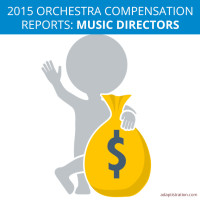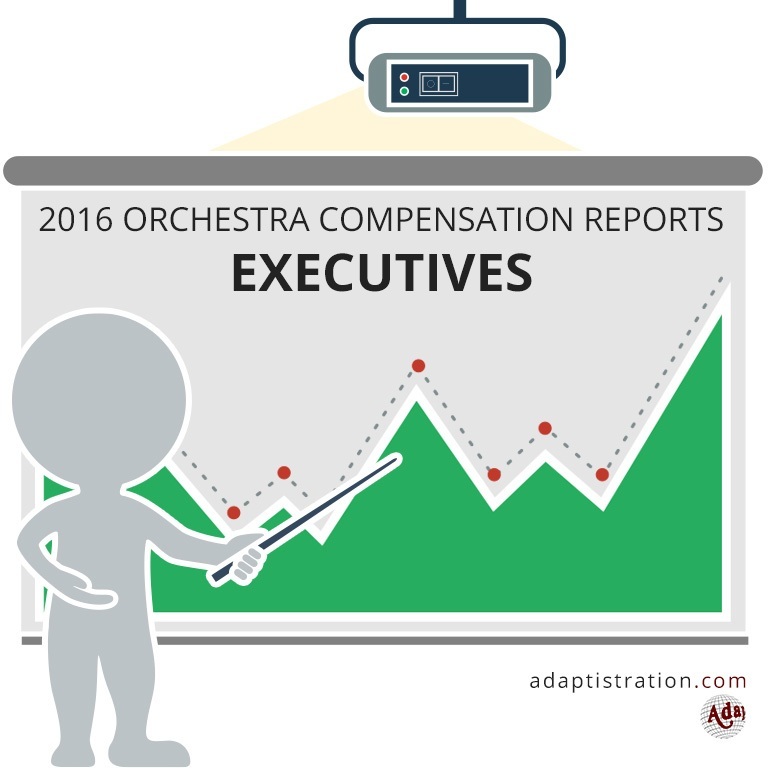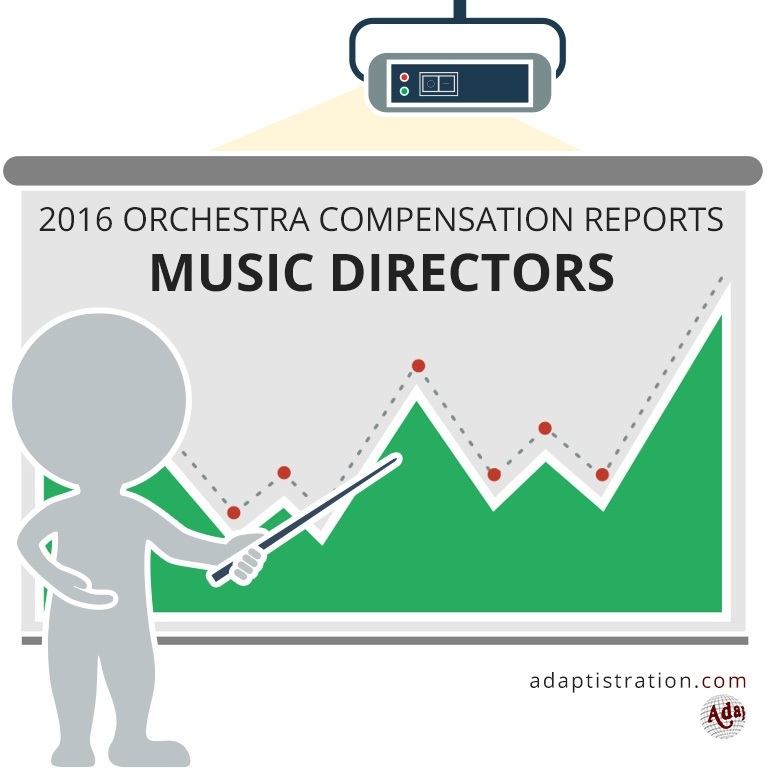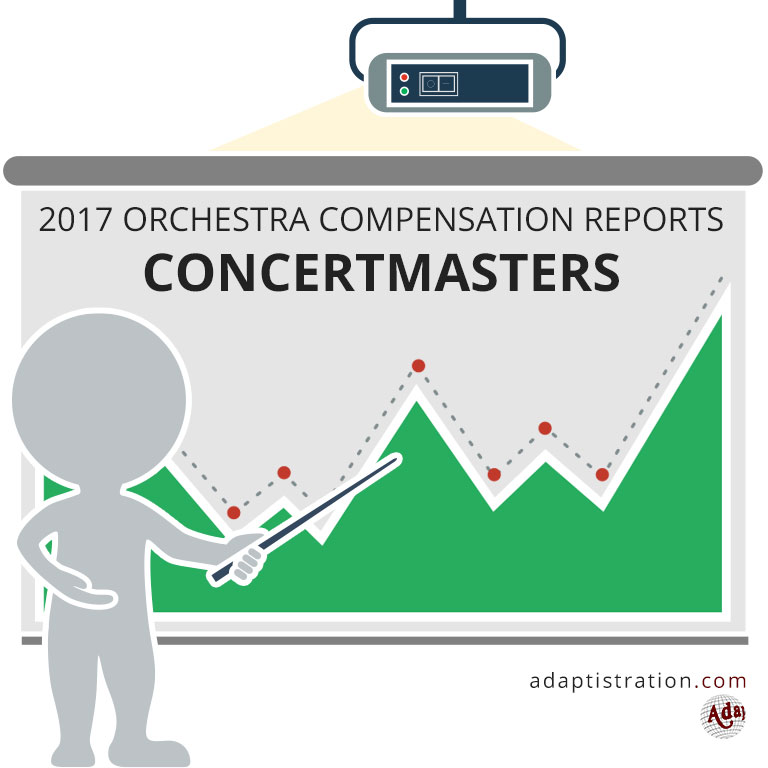For the average music director, the 2012/13 season was a good year financially; although a few high profile positions remained vacant that season, such as Boston and Philadelphia, brought the average increase lower than it would have been otherwise, most music directors saw their earnings increase by 3.43 percent.
The Information
In order to provide information that is as accurate as possible, info from the 2012/13 season is gathered from the following sources:
- Music Director compensation figures were obtained from their respective orchestra’s IRS Form 990 for the 2012/13 concert season.
- Total Expenditures were also obtained from each respective orchestra’s IRS Form 990 for the 2012/13 concert season.
Adaptistration makes no claim to the accuracy of information from documents compiled or reported by external sources. If you have reason to believe any of the information is inaccurate or has changed since reported in any of the above sources and you can provide documentation to such effect, please feel free to use the following form to submit a notice.
What The Data Doesn’t Show
 It is important to remember that the numbers shown do not always convey a complete compensation picture. For example, a music director may have had a large increase in salary because they were leaving a position and per terms of their contract they may have received a sizeable severance or deferred compensation package. As such, the cumulative compensation may artificially inflate annual earnings. Furthermore, these figures may not reflect bonuses or other incentive payments, therefore underreporting what conductors may actually earn.
It is important to remember that the numbers shown do not always convey a complete compensation picture. For example, a music director may have had a large increase in salary because they were leaving a position and per terms of their contract they may have received a sizeable severance or deferred compensation package. As such, the cumulative compensation may artificially inflate annual earnings. Furthermore, these figures may not reflect bonuses or other incentive payments, therefore underreporting what conductors may actually earn.
Also missing from the figures are expense accounts, lodging expenses, and other perks; as such, the cumulative compensation for music directors may or may not be more than what is listed. Additionally, the documents used to gather data do not indicate how much of the season an individual received a salary. As such, excessive adjustments in the percentage change from the previous season’s compensation may be artificially adjusted. Although the music director compensation figures include the combined amounts reported as what the IRS classifies as “compensation” and “contributions to employee benefit plans & deferred compensation,” each orchestra does not always report figures for the latter category.
How Terms Impact Compensation
Unlike executives, concertmasters, and musicians, music directors are sometimes employed as private contractors. In these cases, orchestras will list the music director among the five highest paid private contractors as opposed to sections devoted to employee compensation. In most of these instances, no information about benefits or deferred compensation is available.
Likewise, some music directors receive separate payments for duties associated with their position. For example, for several fiscal years the Seattle Symphony Orchestra paid former music director Gerard Schwarz via two separate private contractor listings: once for music director duties and the other for principal conducting duties. At the Chicago Symphony Orchestra, when Daniel Barenboim was with the organization, he was often paid separately for music director services and then again as conductor and soloist.
In instances such as these, those figures have been combined into a single figure in the table below. For details about each individual conductor’s compensation, please consult the orchestra’s respective IRS Form 990.
A New Trend
One unusual occurrence in the 2012/13 season was an uptick in the practice of a paying music director part of his/her compensation as a private contractor and part as an employee. This is a bit different than the scenarios listed above in that there is not always the same degree of explanation surrounding duties and responsibilities assigned to both types of compensation.
2012/13 Season Music Director Compensation

Top 10 Earners
 There were a few unfamiliar occurrences in this season’s Top 10 list such as Baltimore Symphony paying their music director more than Cleveland Orchestra when the latter’s Total Expenditures ($50,251,033) were twice as high as Baltimore ($25,372,002). Dallas Symphony’s music director skyrocketed to the #5 spot on the list thanks to an 82.57 percent increase over previous season’s compensation; granted, that increase was exaggerated thanks to the previous season only including payments for a partial season of employment but when comparing the 2012/13 figure to the 2010/11 season, the increase is still a much higher than average 46 percent.
There were a few unfamiliar occurrences in this season’s Top 10 list such as Baltimore Symphony paying their music director more than Cleveland Orchestra when the latter’s Total Expenditures ($50,251,033) were twice as high as Baltimore ($25,372,002). Dallas Symphony’s music director skyrocketed to the #5 spot on the list thanks to an 82.57 percent increase over previous season’s compensation; granted, that increase was exaggerated thanks to the previous season only including payments for a partial season of employment but when comparing the 2012/13 figure to the 2010/11 season, the increase is still a much higher than average 46 percent.
- National Symphony: $2,728,671 (41.02 percent increase)
- Chicago Symphony: $2,504,336 (15.65 percent increase)
- San Francisco Symphony: $2,364,775 (16.64 percent increase)
- New York Philharmonic: $1,717,814 (28 percent increase)
- Dallas Symphony: $1,505,052 (82.57 percent increase, but previous season compensation was only for partial season)
- Los Angeles Philharmonic: $1,447,049 (1.54 percent increase)
- Saint Louis Symphony: $1,012,158 (5.51 percent increase)
- Minnesota Orchestra: $944,098 (20.24 percent decrease)
- Baltimore Symphony: $930,914 (5.45 percent increase)
- Cleveland Orchestra: $907,829 (23.15 percent decrease)
An Alarming Practice Continues: Orchestras Obfuscating And/Or Refusing To Disclose Compensation
The 2014 reports introduced the ethically questionable exercise at a handful of orchestras that have adopted the practice of intentionally obfuscating music director compensation and in at least one case, refusing to release the data.
Last year’s infraction involved the Detroit Symphony Orchestra and their decision to refuse requests for music director compensation figures for Leonard Slatkin during the 2011/12 season. Unfortunately, they have continued that position for the 2012/13 season and joining them this time around is the Oregon Symphony, which adopts a practice of concealing music director Carlos Kalmar’s compensation within a lump sum payment to his artist management firm, Cramer/Marder Artists.
Oregon’s practice caught the attention of Oregon Arts Watch’s Barry Johnson who published a comprehensive article about this topic on 10/30/2013. It does an excellent job at focusing on the core issues that may damage an institution’s reputation in the wake of not only being coy about disclosing compensation but intentionally burying it in a payment to a third party independent contractor.
Another wrinkle in the practice of obfuscating music director compensation in this manner is it leaves an institution open to the potential for unwelcome scrutiny via whether or not the music director qualifies as a key employee. In the case of many professional orchestras, the music director serves in a clear managerial role with detailed duties and responsibilities concerning hiring, evaluating, and dismissing musician employees. In short, does an orchestra’s chief artistic executive qualify as an independent contractor when s/he has the authority to fire a musician for musical reasons?
On a closely related item here, it is difficult to miss the uptick in the number of orchestras that report music director compensation split between independent contractor payments and as a key employee. For example, Baltimore Symphony paid Marin Alsop $656,000 as an independent contractor for conducting services along with another $274,914 for employee based music director services.
It is worth noting in Baltimore’s case that even though they paid 100 percent of Alsop’s independent contractor fee to her artist agency, OPUS 3 Artists LLC, they clearly indicated the figure reported was for her services; meaning, they didn’t attempt to bury the compensation along with payments to other artists represented by the same firm.
Consequently, it is good to see that there are still orchestras abiding by ethical standards when it comes to reporting music director compensation and the more this happens, the more pressure it places on orchestras such as Oregon to adopt a similar position.
I contacted Oregon Symphony’s President & CEO, Scott Showalter, to inquire about the institution’s practice of obfuscating their music director’s compensation but he declined to provide any direct quotes and instead, had Jim Fullan, Oregon Symphony VP/Communications, Marketing and Sales, assert that the organization complies with IRS guidelines.
“Unfortunately our policy not to share salary information remains in place and prevents us from providing that information,” wrote Fullan in an email message from 6/22/15.
When asked why Kalmar is not listed as an employee in any capacity yet maintains the authority to hire, evaluate, and fire employees, Fullan avoided the topic and instead, opted to confirm that Kalmar is employed as an independent contractor.
“Our contracting with Cramer/Marder for the services of a conductor/music director falls within the parameters of Oregon statutes regarding independent contractors,” wrote Fullan.
Additional Irregularities
The Spokane Symphony which failed to respond to requests asking why their music director was not listed as an employee nor an independent contractor anywhere in their Form 990 when season’s as back as 2002/03 list music director compensation in excess of the current reporting minimum of $100,000. Lastly, the Louisville Orchestra did not list any compensation for music director although in Part VII, Section B of their 990 they did indicate that there was one independent contractor that received more than $100,000 but they did not list the name and business address, description of services, and compensation figure.



Compared to the average MD salary (et al), concertmasters, who roll in at an average below 300K, are a veritable steal. One has to also remember that the MD of a major orchestra might be on hand as little as eight weeks and probably as many as 12. I long for the day when the absence of “the chief” was the exception and not the rule.
Let it also be said that performance–of the conductor as well as the orchestra–must play a role in compensation. What is the finest orchestra in the country? That’s up for debate but certainly Boston, NY, and LA are in the mix. The most underrated (to those outside of the business) must be Cleveland, simply because of the city’s “rust belt” status. Franz-Welser Most is certainly worth more to his orchestra and his city than other names further up the totem pole. But, just like star athletes, “star conductors”–whether s/he may truly be one or not–seem to command a high price indeed.
Very nice read that I came to through the link on Norman LeBrecht’s Slipped Disc. There is no question that orchestras are operating like corporations. The execs and MDs at the top take their bloated share (with the consent of their boards) and leave the crumbs for the hire help (the orchestra).
How long this type of model can be sustained remains in question. Sure the large orchestras may be able to continue but several orchestras on the list are in deep financial trouble (Memphis and Hartford jump out). Rarely does management take the cuts that they expect from the orchestra musicians.
I agree with the above comment regarding the Cleveland music director. I attended both concerts during the LAO week in MAY and was impressed by both performances of challenging programs.
Until there is more transparency in the financial statements and ways to access more current 990s, there will always be continuing distrust between musicians and management.
And that is unfortunate since both sides need to be rowing the boat in the same direction.
Read Predator Nation by Charles Ferguson for a detailed analysis of what happens when rules of compensation go out the window along with the rule of law. The term “business ethics” becomes a laughable oxymoron. C Suite salaries are no longer related in any material way to performance. The more our non-profits try to adopt this corporate model, the more susceptible they are to this poisonous trend. This abuse of power is especially troubling considering the slim margins on which the average orchestra, dance company, or opera company function.